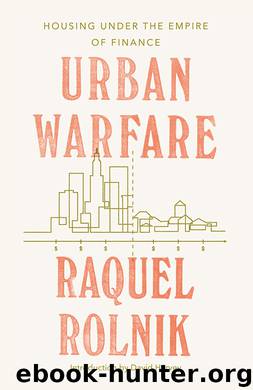Urban Warfare by Raquel Rolnik

Author:Raquel Rolnik
Language: eng
Format: epub
Publisher: Verso Books
Post-Disaster Reconstruction and Dispossession Mechanisms
‘Living in risk’ was how Lúcio Kowarick defined the socioeconomic, political and civil vulnerability of a huge number of poor people in cities in the Northern and Southern hemispheres.25 From this concept, I borrow the idea that the many dimensions of precariousness multiply, making the most vulnerable, such as those living in poverty or with insecure tenure, more likely to live in disaster-prone areas; they are also at greater risk of displacement and loss of livelihood in the event of a disaster; and it is they who will recover with most difficulty.
As previously analysed, the space physically and socially occupied by these populations causes (or, at the same time, results from) discrimination. This compromises the ability of individuals and communities to protect themselves, and to recover, from disasters. The discrimination against communities in disaster-response contexts may not be immediately apparent. Indeed, the term ‘natural disaster’ conceals the social process that constructed the area at risk and that defined how, why and under what conditions it had been occupied.
Evidence of the above statement abounds. When Hurricane Katrina struck New Orleans in 2005, African Americans and poor people (the two categories overlapping to a large extent) bore the brunt of the devastation because, for the most part, they lived in the lower-lying, more flood-prone sections of the city. In addition, because large numbers of the metropolitan area’s population were poor, they lacked the means to escape the flood.26 The particular impacts and costs of the hurricane were therefore intimately linked to pre-existing social, economic and land-use patterns, directly related to housing and urban planning policies.
Post-Katrina responses by the federal and state governments were generally found wanting when it came to supporting lower-income renters — predominantly African American — and addressing the range of obstacles that prevented them from accessing affordable housing. Despite a federal programme of housing vouchers, in practice, families with rent vouchers had difficulty in finding places to rent. The reasons included: public and rental housing shortages (due to storm damage, but also to subsequent decisions to massively cull public housing); rent increases; discrimination by landlords; the slow pace of rental housing construction; and the decision by Gulf Coast states to direct the bulk of federal funds towards repairing homeowner units rather than rental ones. With very limited renting options, many families were de facto denied return to their city and former homes, resulting in a spike in homelessness.27
The destruction of much of New Orleans’s housing stock by Hurricane Katrina was really seen as an opportunity to fundamentally alter the housing and urban characteristics of the city. It is noticeable that the city’s four largest public housing projects (the so-called Big Four), that used to shelter predominantly Afro-American residents, were demolished to make way for requalification projects, designed for mixed-income communities among other uses. Even if in some cases there was probably no alternative, due to the gravity of structural damage to the buildings, the demolitions were framed as necessary for the recovery of the city and for health and safety reasons.
Download
This site does not store any files on its server. We only index and link to content provided by other sites. Please contact the content providers to delete copyright contents if any and email us, we'll remove relevant links or contents immediately.
The Secret History by Donna Tartt(16622)
The Social Justice Warrior Handbook by Lisa De Pasquale(11489)
Thirteen Reasons Why by Jay Asher(7788)
This Is How You Lose Her by Junot Diaz(5770)
Weapons of Math Destruction by Cathy O'Neil(5036)
Zero to One by Peter Thiel(4824)
The Myth of the Strong Leader by Archie Brown(4789)
Promise Me, Dad by Joe Biden(4447)
Beartown by Fredrik Backman(4415)
Stone's Rules by Roger Stone(4415)
How Democracies Die by Steven Levitsky & Daniel Ziblatt(4398)
The Fire Next Time by James Baldwin(4342)
100 Deadly Skills by Clint Emerson(4076)
A Higher Loyalty: Truth, Lies, and Leadership by James Comey(4032)
Rise and Kill First by Ronen Bergman(4012)
The David Icke Guide to the Global Conspiracy (and how to end it) by David Icke(3881)
The Farm by Tom Rob Smith(3872)
Secrecy World by Jake Bernstein(3782)
The Doomsday Machine by Daniel Ellsberg(3730)
